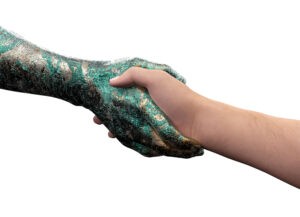
Graham Sharp, MD at Stanley
Is safety a good fit for AI? Graham Sharp at Stanley thinks so. Here he shares how the technology is changing the landscape.
The introduction of Artificial Intelligence [AI] is currently transforming workplace safety and productivity in the UK. The surge in interest follows the US lead where the AI wearable device market for health and safety monitoring is growing exponentially. In the UK, wearable solutions are becoming increasingly popular, with AI health and safety monitoring devices bringing exciting and disruptive change. Wearable devices bring with them a new way of harnessing detailed data that can help inform and improve future workplace health and safety policies within organisations.
One of the biggest reasons that workers take time off sick is due to musculoskeletal disorders (MSDs). In fact, according to the latest figures from the Health and Safety Executive, the total number of cases of work-related musculoskeletal disorders in 2021/22 in the UK, was 477,000 which equates to a total of 27% of all work-related ill health cases and 24% of all working days lost due to work-related ill health. This is a hefty percentage of days lost due to sickness so it’s no wonder that businesses are continuously looking for ways to avoid injury at work and improve workplace safety and wellbeing. The benefits of a health and safety-based AI solution are clear, a healthy, engaged workforce will improve productivity.
Working with safety
So how does this new AI technology work in the context of health and safety? There are several solutions currently on the market in the UK. Providers like WearHealth match the right exoskeleton suit to the activity being performed, with the aim of ensuring their usual daily tasks can be performed with reduced risk of injury or suffering from MSDs. Video scanning technology is used to assess a particular task, make recommendations for exoskeleton suits, and then report back with sensor analysis of the activity. The sensors are worn by the worker to confirm the support delivered by the suit utilising real-time data capture.
Technologies such as the Modjoul SmartBelt prevent injury through real-time feedback and data analysis. The device is attached to a belt and is designed to measure bending, twisting, and other hazardous movement. AI solutions also cover small movement and those at risk of repetitive strain injury. For example, Ansell the world’s largest supplier of PPE, has launched a new pod technology called Inteliforz™ which monitors repetitive hand and wrist movement to protect against a range of injuries including carpal tunnel syndrome.

CREDIT: rico ploeg/Alamy Stock
Real-time data
One of the key benefits of these new wearable AI technology solutions, aside from improvement of health and wellbeing, is the detailed real-time data that businesses can collect related to the workplace environment including department, role, particular task etc. The technology is continuously measuring and tracking progress allowing companies to read granular reporting on bends, twists, stooping, crouching, and reaching, which can be processed in great detail to offer insights into a global workforce risk analysis. This data is invaluable in helping the workplace operate more efficiently and improve workplace wellbeing.
Not only that, but workers themselves are able to track their own progress either on their own mobile phones via a bespoke app or on supplied in-house technology. So, for example, they can track their performance and see whether they are reducing hazardous movements. This can be potentially linked to a rewards-based system where you get a reward when you hit your target. This type of gamification has been shown to improve employee buy-in because the worker is invested in the progress and it also it allows them to feel that the business is committed to improve health and wellbeing which is a great contributor of staff retention.
A change is coming?
This is new technology to the UK, but we are already starting to see early adopters like Currys using Exo Suit technology in its warehouses. There are also increasing numbers of other established big names trialling similar solutions in their warehouses and on the factory floor. In order to see widespread adoption, Health and Safety leaders need to create a strong business case for a new technology which can add value and save money with its potential to transform workplace wellbeing and improve productivity.
We are at the start of a major technology revolution in the health and safety sector. We can see huge technological change happening all around us and AI if used wisely, can offer huge benefits to the workplace in terms of health and wellbeing, productivity, and efficiency. The health and safety AI wearable technologies coming on stream in the UK are really exciting, providing real disruption and change to how businesses protect their workers.
AI on the shop floor – A case study
The Enel Group is a leading manufacturer and distributor of electricity and gas and is present in more than 30 countries including the UK. The company uses sustainable technologies to supply energy to people.
The company identified WearHealth exoskeletons as a potential solution to certain physically challenging operations undertaken by its maintenance workers. The exoskeletons had been tested in terms of usability, comfort, and support, using subjective questionnaires and objective lab data. However, it was not clear how exoskeletons could impact workers’ overall workload in a real work environment over longer periods.
To test this, a group of workers performed maintenance operations with and without an exoskeleton suit. In both cases a wearable device was used to gather heart rate, heart rate variability and movement data. The resulting data was converted to a 1-10 workload scale (physical and mental) using WearHealth’s proprietary artificial intelligence algorithms based on ISO standards. A 27% reduction in workload was identified when workers wore the WearHealth exoskeletons and overall the findings suggested that, during maintenance operations and breaks, the exoskeleton provided support during physically challenging periods and also enabled a faster recovery between demanding tasks. A step-by-step rollout is now planned.
Why should you subscribe to the SHP newsletter?
Do you want the very latest health and safety news, product launches, job listings and expert opinions sent straight to your inbox daily?
The SHP newsletter is essential reading – sign up today to get your hands on all this!



